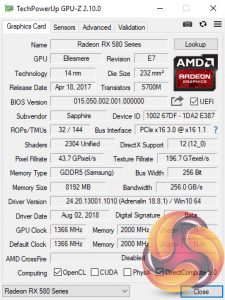For testing the two RX 580 cards today, we ran our games and synthetic benchmarks at 1080p and 1440p. Usually we run tests at 2160p (4K) as well, but since the focus is very much on the differences between the two cards – not overall performance – we have opted to remove the 4K testing as we already know this is not the target market for the RX 580 GPU.
The Nitro+ also has dual-BIOS functionality. One BIOS runs the core at up to 1411MHz, while the other BIOS runs the core up to 1340MHz. We tested using the faster BIOS.
Pulse on the left, Nitro+ on the right
Driver Notes
- AMD graphics cards were benchmarked with the Adrenalin 18.8.1 driver.
- Nvidia Graphics cards were benchmarked with the Nvidia 398.82 driver.
Test System
We test using the Overclockers UK Germanium pre-built system. You can read more about it over HERE. It is important to note we have had to re-house the components to an open-air test bench to accommodate our new GPU power testing (more on that later) but the core of the system is unchanged and the performance figures you see presented here are what you can expect from the Germanium.
| CPU |
Intel Core i7-8700K
Overclocked to 4.8GHz |
| Motherboard |
ASUS ROG Strix Z370-F Gaming
|
| Memory |
Team Group Dark Hawk RGB
16GB (2x8GB) @ 3200MHz 16-18-18-38 |
| Graphics Card |
Varies
|
| System Drive |
Patriot Wildfire 240GB
|
| Games Drive | Crucial M4 512GB |
| Chassis | Streacom ST-BC1 Bench |
| CPU Cooler |
OCUK TechLabs 240mm AIO
|
| Power Supply |
SuperFlower Leadex II 850W 80Plus Gold
|
| Operating System |
Windows 10 Professional
|
Comparison Graphics Cards List
- Nvidia GTX 1060 Founders Edition (FE) 6GB
- Sapphire RX 580 Nitro+ 8GB
- Sapphire RX 580 Pulse 8GB
- ASUS RX 570 ROG Strix Gaming OC 4GB
Software and Games List
- 3DMark Fire Strike (DX11 Synthetic)
- 3DMark Time Spy (DX12 Synthetic)
- Deus Ex: Mankind Divided (DX12)
- Far Cry 5 (DX11)
- Tom Clancy’s Ghost Recon: Wildlands (DX11)
- Middle Earth: Shadow of War (DX11)
- Rise of the Tomb Raider (DX12)
We run each benchmark/game three times, and present averages in our graphs.
 KitGuru KitGuru.net – Tech News | Hardware News | Hardware Reviews | IOS | Mobile | Gaming | Graphics Cards
KitGuru KitGuru.net – Tech News | Hardware News | Hardware Reviews | IOS | Mobile | Gaming | Graphics Cards




